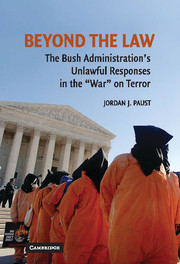Book contents
- Frontmatter
- Contents
- Preface
- Acknowledgments and Permissions
- ONE Executive Plans and Authorizations to Violate International Law Concerning Treatment and Interrogation of Detainees
- TWO Additional Revelations Concerning Treatment, Secret Detentions, and Secret Renditions
- THREE War and Enemy Status
- FOUR Judicial Power to Determine the Status and Rights of Persons Detained Without Trial
- FIVE Executive Claims to Unchecked Power
- SIX Antiterrorism Military Commissions
- Notes
- Name Index
- Subject Index
Preface
Published online by Cambridge University Press: 24 November 2009
- Frontmatter
- Contents
- Preface
- Acknowledgments and Permissions
- ONE Executive Plans and Authorizations to Violate International Law Concerning Treatment and Interrogation of Detainees
- TWO Additional Revelations Concerning Treatment, Secret Detentions, and Secret Renditions
- THREE War and Enemy Status
- FOUR Judicial Power to Determine the Status and Rights of Persons Detained Without Trial
- FIVE Executive Claims to Unchecked Power
- SIX Antiterrorism Military Commissions
- Notes
- Name Index
- Subject Index
Summary
Within a few months after al Qaeda's unlawful terroristic attacks inside the United States on September 11, 2001, the Bush administration embarked on a “dirty war” response to terrorism involving methods of detention, treatment, and interrogation that Vice President Cheney had generalized as responses on “the dark side.” The “dirty war” would involve at least cruel and inhumane treatment of captured human beings and the forced disappearance of various detained persons, despite the fact that cruel and inhumane treatment and forced disappearance are well-known examples of conduct that is absolutely proscribed under several treaties of the United States and customary international law. In fact, both forms of manifest illegality are among recognized peremptory prohibitions of the highest sort that apply in all contexts without exception.
The “dark side” methods, Cheney had argued, should be “done quietly,” but they were used so widely and for so many years that complete secrecy was not possible. Opposition by various U.S. military, Federal Bureau of Investigation (FBI), and Central Intelligence Agency (CIA) personnel contributed to increased public exposure. When pictures of outrageous abuse of detainees at Abu Ghraib, Iraq, became widely publicized, the secrecy of Executive plans and authorizations, despite vigorous denial of their existence, began to unravel. Soon a series of classified memos and letters were leaked that demonstrated the role that several lawyers and others had played in attempts to deny international legal protections to al Qaeda and Taliban detainees, to reclassify their status, and to subject them to unlawful coercive interrogation tactics with alleged impunity.
Information
- Type
- Chapter
- Information
- Beyond the LawThe Bush Administration's Unlawful Responses in the "War" on Terror, pp. ix - xiiPublisher: Cambridge University PressPrint publication year: 2007
Accessibility standard: Unknown
Why this information is here
This section outlines the accessibility features of this content - including support for screen readers, full keyboard navigation and high-contrast display options. This may not be relevant for you.Accessibility Information
- 1
- Cited by
